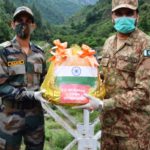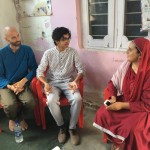Says previous govt had completed 90 pc spadework on dispute; ‘we agreed on a point between complete independence and autonomy’
By Babar Dogar & Ranjan Roy
LAHORE: Former foreign minister Khursheed Mehmood Kasuri has said the solution to the Kashmir dispute is just a signature away once India and Pakistan decide to pull the file from the rack.
While addressing the concluding session of the two-day seminar – held as part of the ongoing Aman ki Asha campaign, launched by the Jang Group and Times of India – and later talking to The News and the Times of India here on Friday, the former foreign minister revealed the previous Musharraf government had completed almost 90 per cent of the spadework on the half-a-century old Kashmir dispute by 2007 as the whole exercise just needed the formal signature of all the three parties to the issue – Pakistan, India and representatives of Kashmir.
“All India and Pakistan now need is to defreeze the process. The entire paper-work has been done. The copies of related documents are safe with some friendly countries as well,” said Kasuri.
Kasuri said that negotiators from Islamabad and New Delhi had quietly toiled away for three years, talking to each other and Kashmiri representatives from the Indian side as well as Kashmiris settled overseas to reach what he described as the “only possible solution to the Kashmir issue”.
He said the two sides had agreed to full demilitarisation of both Indian Kashmir as well as Azad Kashmir. In addition, a package of loose autonomy that stopped short of the azadi and self-governance aspirations, had been agreed on and was to be introduced on both sides of the disputed frontier. “We agreed on a point between complete independence and autonomy,” he said.
He said that hardliner Sayeed Ali Shah Gilani was the only Kashmiri leader who refused to come on board. “He would accept nothing but merger with Pakistan, which ironically is something we too wanted but knew wasn’t practical. I once had a seven-to-eight hour meeting with him and even Musharraf met him but he refused to budge,” Kasuri said. He refused to give details of the stance other moderate Kashmiri leaders adopted.
He said the former government had finalised the formula of giving independence to the Kashmiris like the one they had before the dispute surfaced in 1948. When Pakistan and India decided to engage the Kashmiri leadership, it made it clear the people of Kashmir would not settle for anything less than the kind of independence they had during the tenure of the maharaja before the partition. However, with the scenario changed altogether, and Pakistan and India having strategic compulsions against such an independence, the issue had to be worked out again on different lines.
Well, India and Pakistan had serious reservations over that kind of independence. So, it was decided let the Kashmiris have their homeland as desired by them, and Pakistan and India should roll a plan for gradual evacuation of the strategically important parts of the united Kashmir,” the former foreign minister informed.
It was also decided both the countries would gradually withdraw their forces from Indian and Pakistani held territories of Kashmir. We decided a nominal chunk of forces would be kept back in the strategically important areas of liberated Kashmir for sometime,” he added.
Furthermore, Kasuri went on to say, Indian and Pakistani governments decided not to sell victories in their respective countries for avoiding a general public backlash in the other. It was a dicey situation in terms of political fallout of any solution back home in both the countries. If that exercise had to materialize, both the countries needed to tell their respective masses what actually had been done for breaking the status quo,” Khursheed Kasuri said. He maintained it was very hard for making the public accept the achieved results either. So, at one point in time, it was decided to make the Line of Control (LoC) `irrelevant’ so that the Kashmiris could be allowed to move freely across the Valley, using their ID cards.
He said: The two nuclear neighbours were quite worried about the volatile situation in the region, especially around the LoC. There were insurgencies in both the countries. The freedom struggle in Indian-held Kashmir and the growing menace of terrorism in Pakistan were becoming a cause of serious concern for the two governments by the end of 2005. The Mumbai attack worked as a catalyst for finding an immediate solution to all issues, which had the potential of sparking a full-fledged armed conflict in the subcontinent. Kasuri further explained both the countries just couldn’t afford any Mumbai-like attack in India as it would force them to retaliate at all costs.
He said the three-year long arduous efforts were rendered fruitless by the sudden emergence of the judiciary-executive row in 2006, which forced the Musharraf regime to put the matter on the backburner for the time being. Kasuri further revealed former president Pervez Musharraf had a possible signal from the Manmohan Singh government in early 2006 vis-vis formalizing the almost reached solution in August 2006. Or, if delay was inevitable, the announcement to this effect could be made by March 2007. However, Kasuri added, he suggested President Musharraf to hold the process back for a while as the political situation in Pakistan was not conducive for unveiling such a big plan, which had the popular sentiments involved to a great extent. As the media, the opposition, the people, especially the civil society and the lawyer community, resorted to opening afterburners against the former president in the aftermath of the judicial crisis, any initiative, however sincere and productive, by the government would be eyed with suspicion.
He said to soften public opinion before making this breakthrough public, India and Pakistan decided to resolve the Sir Creek issue. Indian PM Manmohan Singh was scheduled to come to Pakistan in 2006 for signing the settlement of the Sir Creek issue. However, the Indian government postponed the meeting in view of general elections in India the same year. The Sir Creek matter was put ahead of the already agreed agenda on Kashmir with the purpose to give more credibility to Indo-Pak endeavours. “There was a usual perception that Pakistan and India just couldn’t resolve any mutual dispute through bilateral engagements,” said the former foreign minister.
By that time, Pakistan and India had already held over 15 informal meetings for chalking out a feasible plan to settle the dispute. In the latter part of the deliberations, both the countries realised the need for involving the crucial party to the conflict, the Kashmiris, in the ongoing negotiations. Apart from Indo-Pak meetings during the process, India and Pakistan held talks at various levels with the Kashmiri leadership. “I had held covert meetings with the Kashmiri leadership even in other countries,” Kasuri added. Meanwhile, a senior Indian official involved in the backdoor talks corroborated the statement of the former forign minister.
Kasuri was all praise for the Jang Group of Publications and the Times of India Group. He said only the media had the guts and the credibility to take such an initiative of warming the process again, which was a whisker away from glory. “The media can make the difference at this point in time. If more credible media groups joined the cause, wonders could be done in near future. I hope these two media giants kept the momentum up for sometime till the respective audience realised the significance of peace in the region.” Kasuri stressed the need for frequent media people movement across the border, which, he believed, would go miles in propelling this vital campaign.











